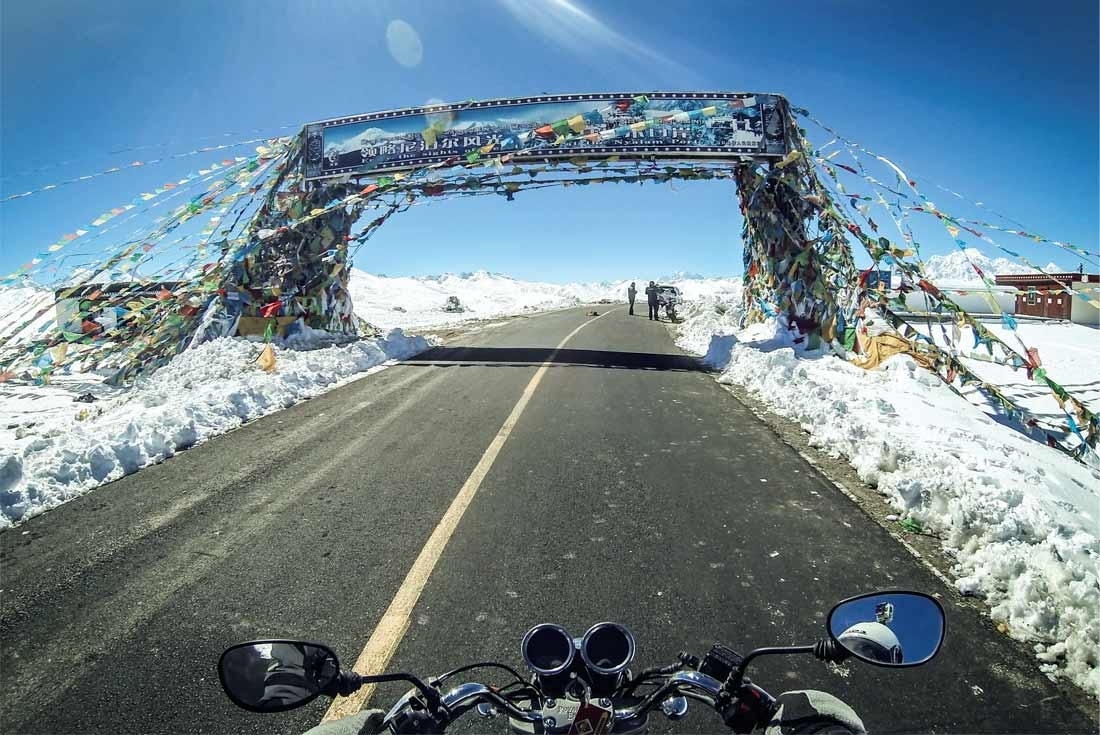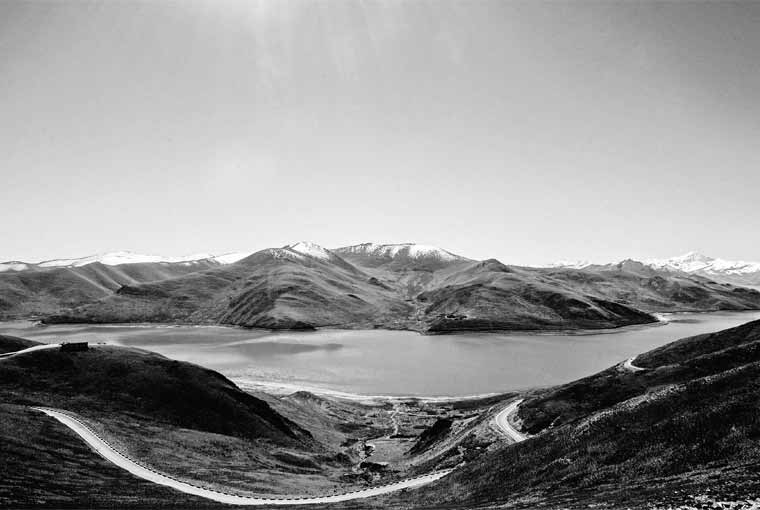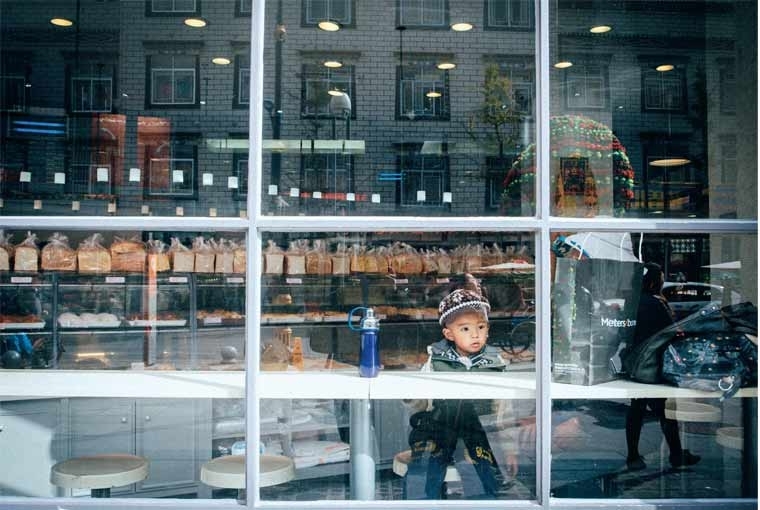

Exploring a destination as mysterious as Tibet, while on a motorcycle, was without a doubt one of the best decisions I could have ever made. Out of the comfort zone that a car would offer you, the motorcycle lets you experience the best, and as we learnt, the worst of nature. The journey within Tibet begins the moment you cross the halfway mark on the militarized Sino-Nepal Friendship Bridge which spans across the Bhote Kosi River. Inside Tibet, the terrain suddenly changes as you escape the chaos of the trade towns on the border and are soon surrounded by the snow-capped mountains of the Himalayas that border the vast Tibetan Plateau. Within a matter of 60 kms, the weather and the terrain changed dramatically from a pleasant sunny border at 2300m, to our first stop in the freezing town of Nyalam at 3750m. We realized that this was no ordinary journey in the Lower Himalayan Range; we were now in the lap of the mighty Himalayas, aptly named the ‘roof of the world’.
In Nyalam, time seems to have come to a standstill. Although the sun had just begun its descent behind the mountain ranges, the town had already gone back to sleep. Barring a selected few provision and electronics shops, a cyber-café with teenagers lost in the world of online gaming and a dimly-lit restaurant, everyone else had retired to the comfort of their homes. Life here is dictated by the daylight hours and keeps changing each season. Often dubbed as the ‘Third Pole’, temperatures fall below -35 degrees Celsius with certain parts of the region facing freezing conditions for as many as 320 days in a year. In such inhospitable conditions, people are restricted to finishing their daily outdoor chores as long as the sun keeps them warm enough with no regard to the clock.

Yamdrok Lake
The influx of Chinese immigrants and their preference for their own cuisine has left very few of the traditional Tibetan restaurants still in business. But the ones that are still in business have a certain charm about them. The wood crackles in the fireplace as we make ourselves comfortable in the warmth of the restaurant. Massive circular tables with cosy sofas, accompanied by embroidered blankets and pillows welcome us. Tradition demands that all meals, be it for a fam¬ily or a group affair, must have copious quantity of thukpa, mutton, Yak meat and momo’s served in humongous bowls. The smaller bowl for vegetarians was brought to the table on request. Tibet is not too inviting a region for vegetarians, since it is high up in the Himalayas where not a blade of grass grows, except for barley. Yak meat dominates the supper with everything from the tongue to testicles on offer.
As I help myself to a generous serving of thukpa, I can¬not help but complain about the absolute absence of spic¬es. This extends to every other dish on the table and since every traditional restaurant has the same cuisine to offer, the monotony in flavour is spread across the country. By the third day, we had sold our souls to the devil and moved to the Chinese joints. Back in Nyalam, as we wrapped up our din¬ner, the silence of the restaurant was broken by loud shouts
of ‘shyabdak’ (the local word for ‘cheers’) in a quaint little room the next door. The drinking had begun as Tenzing, our guide, caught up with a few locals over a traditional, albe¬it difficult board game of Sho, which is played with shells, coins and dice. The rounds are usually accompanied by barrels of beer.
Lhasa Beer, made in the highest brewery in the world, brands itself as the ‘Beer from the Roof of the World’ and is a must have! While Buddhism prohibits the consumption of alcohol, at 5 Yuan, this beer is cheaper than a bottle of water and is slowly being consumed by more and more peo¬ple. Unlike in the rest of the world, beer in Tibet is served in shot glasses as crates of beer cans are stocked next to each table. A waiter will always be around to refill the glass each time you have gulped down a shot, resulting in a lot more consumption than what one would have had directly from a can.
Arriving at Lhasa, one realizes the true gamut of change that People’s Republic of China has brought to Tibet. While the final stretch of the road, aptly named the Golden Road to Lhasa, justified the aura of the fabled city, the setting turns a new page once within city limits. Overcrowded lanes lined with high street boutiques, multi-floored malls housing the best international brands, lavish cafés and restaurants, and a scaled-down version, albeit similarly named, Times Square make Lhasa look like a slice out of New York City. Swanky gadgets replace the prayer wheels in the hands of the locals who opt for chic clothing and Italian leather jackets over traditional wear. Construction sites and superficial tourist attractions are everywhere as the city’s religious and cultural traditions are now censored and curated to be an economic commodity. ‘It will soon be Lhasa Vegas, the Las Vegas of the East,’ Tenzing tells us, reiterating the now common gibe.
There was no doubt about our first stop within Lhasa. We had already caught a glimpse of the glorious Potala Palace in the distance, during our foray into the city. Built during the 7th century, then destroyed by weather and war and consequently rebuilt brick-brick to exactly the same structure in the 17th century by the 5th Dalai Lama, makes it a masterpiece of sacred architecture. Climbing the several flights of stairs and exploring the grandeur of the palace can be a daunting task, especially since even a few steps leave you breathless due to low oxygen levels. But having huffed and puffed my way to the top, the view was worth every bit of effort. For a moment, one can visualize how it must have been when the palace served as the administrative headquarters overlooking the entire city of Lhasa, engulfed by mountains on the horizon. The courtyards are crowded with Tibetans from across the province paying their respects to the structure they look up to as a symbol of a hopeful independent nation. Potala Palace brings to life the splendid stories of Heinrich Harrer as in the book Seven Years in Tibet inspite of the obviously visible fact that the Lhasa he speaks about, has long ceased to exist.
Early next morning, Tenzing hurriedly shoves us into a taxi to take us to the Jokhang Temple. One can tell the excitement on his face. The 1300-year-old Jokhang Temple, nestled in the heart of Lhasa, is the spiritual epicenter for all Tibetans. It is only when you are here that you can under-stand the magnitude of its importance. The beauty of the historic architecture of the building, the serene environment that surrounds it, the bustling local market which is perhaps the only stop for authentic Tibetan souvenirs and most importantly, the devotion Tibetans have towards it, makes it a magnificent sight. Every day, several pilgrims from all over the Tibetan plateau walk hundreds of kilometers, prostrating themselves on the ground every third step, to make the spiritual journey to the Golden Buddha of Jokhang Temple. On any given day, one finds thousands of worshippers in the peripheries of the temple, twirling their prayer wheels or working their prayer beads. Access within the temple is limited to Tibetans, although we managed to catch a glimpse of the Tibetan monks reading scriptures in unison in the ground floor chapel.

Child in a cafe
Lhasa is a perfect illustration of the current day struggle that Tibet faces. Explosive commercial growth, rapid urbanization of the erstwhile lifestyle and constant monitoring of the civilian life engulfs the timeless rituals of faith and peace. The most reliable and best way to experience Tibet is via the whispers you hear rather than the sights you see.
On our last day in Tibet, we stayed in the trade town of Zhangmu, a few kilometers before the border. Believing we had experienced all the surprises that Tibet had to offer us, we decided to head out for one last tryst with Lhasa Beer. Instead of the usual lull and silence that we had got accustomed to, we could hear hushed sounds of pop music blaring out from speakers in the several hidden underground pubs of this mountain town. Once inside, we were transported to the nightlife one is accustomed to in a city like Mumbai—a spacious dance floor, neon-lit cubicles, pop music from every corner of the world and a crowd of young, elaborately dressed Tibetans. It was a sight we were not prepared to see in an otherwise blink-and-miss hideout. Tenzing had left us on our own and joint the celebrations on the dance floor. A few drinks and joyous cheers later, the DJ began playing a popular Hindi item number; we had clearly made our presence felt!
Well past midnight, when we finally decided to retire to our hotel, the locals were still dancing to the tunes of some excellent underground Tibetan pop music. We were told that the party would go on till the wee hours in the morning and would only stop when the last patron had left. In the drunken haze, I could not help but juxtapose this experience with the story of Tibet: a magnificent celebration of life and culture, hidden from the world on the top of the world, which will go on till the end of time as long as a Free Tibet continues to blossom in the hearts of its inhabitants.
Text & Photographs Ketan Kundargi